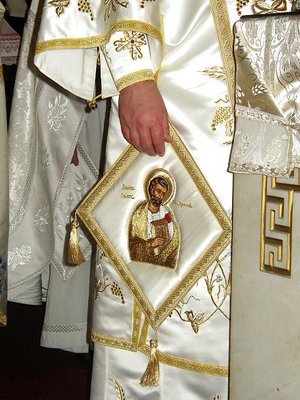Difference between revisions of "Epigonation"
(corrected Greek name - exomologoumenos is "one who is confessing" while exomologos is the one who hears the confession.) |
|||
| Line 1: | Line 1: | ||
[[Image:Epigonation.jpg|right|thumb|300px|Epigonation of Bp. [[Mark (Maymon) of Toledo]], featuring his patron saint, the [[Apostle Mark]].]] | [[Image:Epigonation.jpg|right|thumb|300px|Epigonation of Bp. [[Mark (Maymon) of Toledo]], featuring his patron saint, the [[Apostle Mark]].]] | ||
| − | The '''epigonation''' ( | + | The '''epigonation''' (Greek: ἐπιγονάτιον, literally meaning "over the knee"), or '''palitza''' (Russian: палица, "club"), is a diamond-shaped vestment worn on the right side by [[priest]]s and [[bishop]]s. |
In the Byzantine tradition, the epigonation is awarded to a priest upon his elevation to ''exomologos'' (confessor) or the rank of οικονόμος. In the Russian tradition, it is an award given after many years of service. | In the Byzantine tradition, the epigonation is awarded to a priest upon his elevation to ''exomologos'' (confessor) or the rank of οικονόμος. In the Russian tradition, it is an award given after many years of service. | ||
| − | It represents a shield, originating from the thigh shield worn by soldiers during the days of the early church. The epigonation holds a dual meaning. First, it denotes the celebrant as a "soldier" of Christ. Second, it symbolizes the Word of God, fighting the wiles of the enemy | + | It represents a shield, originating from the thigh shield worn by soldiers during the days of the early church. The epigonation holds a dual meaning. First, it denotes the celebrant as a "soldier" of Christ. Second, it symbolizes the Word of God, fighting the wiles of the enemy. |
{{stub}} | {{stub}} | ||
Revision as of 04:48, March 23, 2012
The epigonation (Greek: ἐπιγονάτιον, literally meaning "over the knee"), or palitza (Russian: палица, "club"), is a diamond-shaped vestment worn on the right side by priests and bishops.
In the Byzantine tradition, the epigonation is awarded to a priest upon his elevation to exomologos (confessor) or the rank of οικονόμος. In the Russian tradition, it is an award given after many years of service.
It represents a shield, originating from the thigh shield worn by soldiers during the days of the early church. The epigonation holds a dual meaning. First, it denotes the celebrant as a "soldier" of Christ. Second, it symbolizes the Word of God, fighting the wiles of the enemy.
This article or section is a stub (i.e., in need of additional material). You can help OrthodoxWiki by expanding it.
